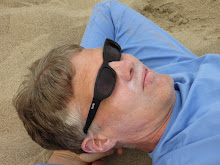From a posting on the Ernest Becker listserv:
I work in the environmental restoration field, and I have recently been taken with the work of David Sobel of Antioch New Hampshire. I heard him speak at the National Recreation and Parks Association Environmental Summit in Portland in 2008. He wrote a wonderfully thin book called "Beyond Ecophobia" where he argues against teaching "gloom and doom" environmental curriculum to elementary age children. Instead, he argues for "curriculum" that contains an abundance of unstructured play and just enough teaching to satisfy the student's natural curiosity about his/her world. This parallels developmental capacity. The young child's developmental task is to bond with the local environment. Asking him or her to identify with the rainforest or polar ice caps is not an abstraction that he or she is capable of. Abstract and relational thinking develops in adolescence and that is where the gravity of environmental issues can first be effectively introduced, according to Sobel.
He gives an illustrative example from one of his researchers, Steve Moore. Moore interviewed students in four classrooms. He showed them 25 iconic pictures and asked them choose three pictures that seemed most important to them. In two of the classrooms, the children picked pictures like an eagle, earth from space, a deer. In the other two, the children picked the baseball, home, and dog pictures. In the interviews, the children in the first two classrooms the children talked about saving the planet, stopping pollution, protecting eagles. But they didn't seem to enjoy the activity. The children in the second two classrooms talked about home, family, pets and were enthusiastic about the activity.
The researcher returned to interview the teachers. It turned out that the teachers in the first two classrooms had conducted an Earth Day unit recently, while the teachers in the other two classrooms had (apologetically) just taught regular curriculum. When he tallied up the responses from the student interviews, he noticed that actually more children expressed an appreciation for the natural environment from the non-Earth Day classrooms. While the Earth Day students expressed concerns for many things, they expressed little appreciation their world. His overall conclusion was that the Earth Day students' natural interests in their friends, families and play had been squashed by their awareness of global problems. This observation has been supported by research in Germany in the aftermath of Chernobyl. German schools launched a curriculum to raise awareness of nuclear issues, hoping to created empowered global citizens out of school children. However, in follow up studies, researchers found students felt hopeless and disempowered.
Elsewhere, Sobel talks about a movement in Freeport Maine to ban styrofoam containers. Apparently, high school students did a unit on global warming and the following week were out picking up litter on the highway. When they noticed how much of the litter was styrofoam food containers, they petitioned the City Council to ban the CFC containers. The Council did so, and McDonalds quickly stepped in to sue. The City of Freeport eventually won the case with support from the students.
The backstory on this is that the high school leaders of the CFC ban had mostly come from one of the elementary schools. This particular school had a 2/3 acre woods next to the schoolyard. The students played in there at recess everyday. They built forts, houses, roads. They formed clans, bartered for goods. They even had money in the form of asphalt chunks. The more glittering mica in the chunk, or the bigger the chunk, the more valuable. These woods were for all practical purposes off-limits to the adults. Students who complained about something that happened in the woods were told to work it out with the other kids. I am sure that these woods were heavily impacted from an environmental standpoint - the understory trampled, bare dirt everywhere. But it seems that the experience of peer-to-peer play in the natural environment taught caring for a place as well as social order and leadership skills to enough of the participants that they were able to take those abilities and convert them to real-world issues as adolescents.
My musing about this here is about developmental psychology and death-denial. It seems that children's defenses are not fully formed and neither are their cognitive abilities. Therefore they are vulnerable to "real world" information damaging their sense of self and security. I find it ironic and perplexing that perhaps to foster the future generation of environmental leaders we have to protect them from death awareness up to a point. Which makes me wonder if our insistence on teaching "gloom and doom" currriculum comes from adults trying to "client" their death anxiety onto school children. I can hear ourselves collectively saying,"Oh, my god, the world is really a mess. Since I am not together enough to do anything about this myself, I will place my hopes on the next generation and make sure they understand what they are getting into. Maybe they will have a better chance of doing something than I have in my self-paralysis."
It makes me also consider one of the differences between a "heroism" that serves humanity and one that is damaging. It may have to do with how well attached and secure a child is able to become in his or her world at an early age. Then the heroism is guided partly by deep structures in the cortex and limbic systems. I would appreciate hearing what others may have written about this idea.
Paul
skip to main |
skip to sidebar

Search This Blog
Followers
Blog Archive
About Me

- peedub
- I am an urban forester focusing on restoration of natural areas within cities. I also live in a cohousing community that is based on 2 acres within the city limits.